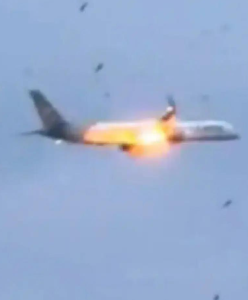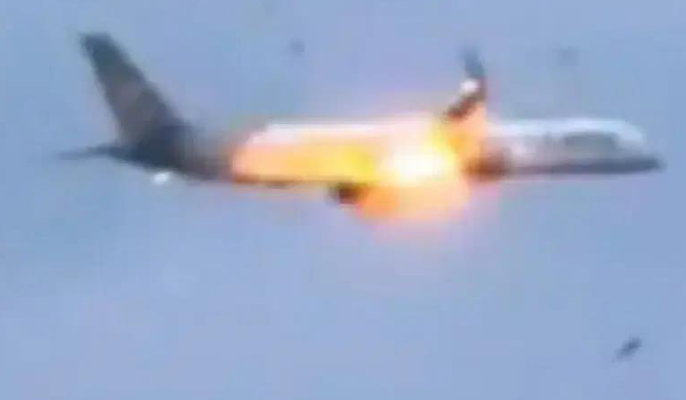
Shock Moment: Boeing Plane Engine Bursts Into Flames, Forcing Emergency Landing as Passenger Says “I Sent Goodbye Texts”
The flight began as countless others do—boarding calls echoing through the terminal, suitcases rolling over tiled floors, the quiet excitement of travelers heading home or chasing adventure. No one could have imagined that within an hour, hundreds of lives would hang in the balance thousands of feet above the earth.
It was a Boeing aircraft, operated by Condor Airlines, carrying more than two hundred passengers from Corfu, Greece, to Düsseldorf, Germany. The crew followed every routine, the takeoff smooth, the seatbelt signs eventually dimming as the plane climbed steadily toward its cruising altitude. Cabin chatter filled the aisles, children pressed their faces against the windows, and flight attendants began serving drinks. Everything felt perfectly ordinary—until, in a blink, it wasn’t.
At about thirty-six thousand feet, a deep rumble rippled through the cabin. Passengers at first assumed it was turbulence, but the vibration grew violent. Trays rattled, cups spilled, and a collective unease spread. Then came a flash—a flare of orange fire on the right wing. Gasps turned into screams as flames burst from the engine, bright against the fading daylight.
“It looked like the whole side of the plane was on fire,” one passenger recalled later. “People started crying, praying. I thought, ‘This is it.’”
In that instant, life stripped itself down to raw fear. The smell of burning fuel seeped faintly through the vents. Someone shouted for the flight attendants; another clutched a stranger’s hand. The plane shuddered again. The sound was like thunder trapped inside a metal box.
Inside the cockpit, alarms blared. The pilots’ training kicked in—the kind of calm precision only years of experience can teach. They cut fuel to the affected engine, rerouted power, and radioed for an emergency landing. Brindisi, Italy, was the closest safe runway. Every second now mattered.
Back in the cabin, passengers watched the flames flicker outside their windows. “I remember pulling out my phone,” said a young woman named Sara. “My hands were shaking so badly I could barely type. I texted my parents, my boyfriend. I told them I loved them. I really thought those would be my last words.”
Others followed suit, whispering quiet goodbyes into their screens, sending photos, prayers, and trembling emojis into the digital void. The cabin crew moved swiftly through the aisles, voices steady despite the chaos. “Please remain seated. Fasten your seatbelts. We are making an emergency landing,” they repeated. Their calm was an anchor in the storm.
As the Boeing began its descent, the fire appeared to dim, but the tension inside the plane only grew heavier. Every minute stretched into an eternity. Mothers held their children tight; couples prayed aloud; strangers wept in silence. The steady hum of the remaining engine was the only reassurance that they were still flying, still alive.
Through the cockpit window, the lights of Brindisi Airport appeared—a runway glowing like a lifeline in the dark. The captain guided the aircraft lower, lower, until the landing gear screeched against asphalt. The plane rattled violently as it slowed, smoke trailing behind. Then, finally, it stopped.
For a few seconds, no one moved. The silence was almost sacred. Then came applause—tentative at first, then swelling into cheers. People sobbed openly, hugging whoever was closest. Some were too stunned to react, staring blankly ahead, trying to understand what had just happened.
Fire trucks surrounded the aircraft in seconds. Streams of white foam sprayed across the damaged engine as emergency lights bathed the tarmac in red and blue. The crew guided passengers out calmly, row by row, down the emergency slides. When feet finally touched solid ground, many kissed the pavement.
No one had been injured. Not one life lost.
Outside, the sight of the plane was haunting—its right engine charred, streaks of soot marking the wing. Investigators quickly moved in, cordoning off the area. Technicians worked through the night to determine the cause. Preliminary reports pointed to an airflow disturbance in the combustion chamber, but deeper inspections would follow. Condor Airlines issued a statement calling the landing “precautionary,” insisting the safety of passengers had never been at risk. But for those who had watched fire lick the metal inches from their windows, the official language offered little comfort.
Inside the terminal, the reality of survival began to sink in. Passengers were provided blankets and water as staff scrambled to find hotel rooms in the small Italian city. There weren’t enough. Many ended up sleeping on benches or the airport floor. Yet no one complained. They were alive, and that was enough.
By morning, replacement aircraft arrived to take them onward to Düsseldorf. The mood aboard was different now—quieter, heavier. Conversations drifted toward what-ifs, toward reflections on fragility and fate. Some exchanged numbers with strangers who had held their hands the night before. Others sat alone, staring out the windows at the endless blue sky, trying to make peace with it again.
In the days that followed, the story spread across news outlets worldwide. Videos captured by passengers showed the engine glowing red midair, tiny bursts of flame flickering against the wing. Commentators debated airline safety, maintenance standards, and Boeing’s reputation. But amid all the analysis, the human stories stood out most—the trembling voices of those who had lived through the impossible.
“I keep thinking about the moment I pressed send,” said one man. “That goodbye message. I meant it. I really did. But then I landed, and I got to delete it. I don’t know how to explain that kind of gratitude.”
Psychologists later noted that survivors of in-flight emergencies often describe the same paradoxical feeling—terror followed by an almost painful appreciation for ordinary life. The taste of morning coffee. The sound of a loved one’s laughter. The simple act of waking up.
For many, the experience reshaped their understanding of control. Flying, once routine, became a reminder that life is never guaranteed. Some swore they’d never board a plane again. Others said they’d travel more than ever, unwilling to let fear shrink their world.
In the months after the incident, Condor Airlines confirmed the engine had experienced a rare internal airflow malfunction. Engineers replaced components and reviewed safety protocols across their fleet. Regulators praised the pilots for their professionalism and credited the crew’s quick actions for preventing disaster.
But for those onboard, the true story wasn’t mechanical—it was human. It was the trembling of fingers over phone screens, the stranger who offered a prayer, the child who whispered, “Are we going to see the stars again?” It was the collective heartbeat of hundreds who, for a few terrible minutes, stared death in the face and chose hope anyway.
When the passengers finally reunited with their families, hugs lasted longer. Conversations slowed. The words “I love you” carried new weight.
And somewhere in all that fear and relief, there was a lesson that no technical report could capture—that life, however fragile, is still a miracle every time the wheels lift off the ground and again when they touch back down safely.
For those who looked out the window and saw fire in the sky, survival became more than luck. It became a vow—to live a little louder, love a little deeper, and never again take an ordinary flight for granted.
One passenger summed it up simply: “I thought my last words were sent through a text message. But instead, I got to say them in person. That’s something I’ll thank the universe for every day.”
And so, what began as a nightmare ended as a quiet miracle—a story not just of malfunction and fear, but of resilience, humanity, and the indescribable relief of another sunrise.

